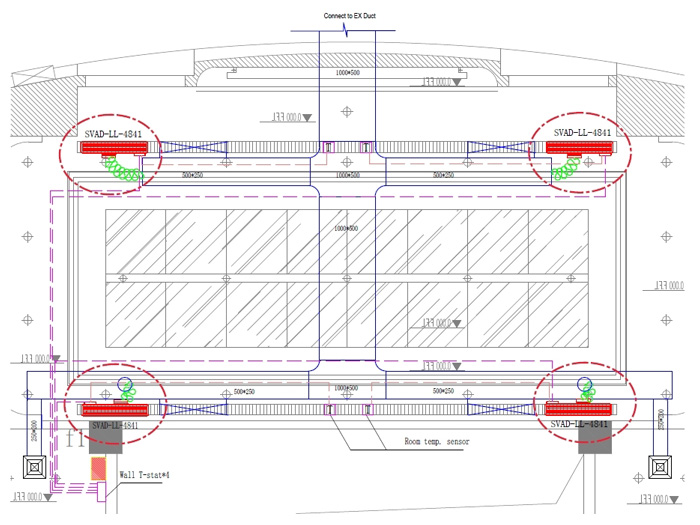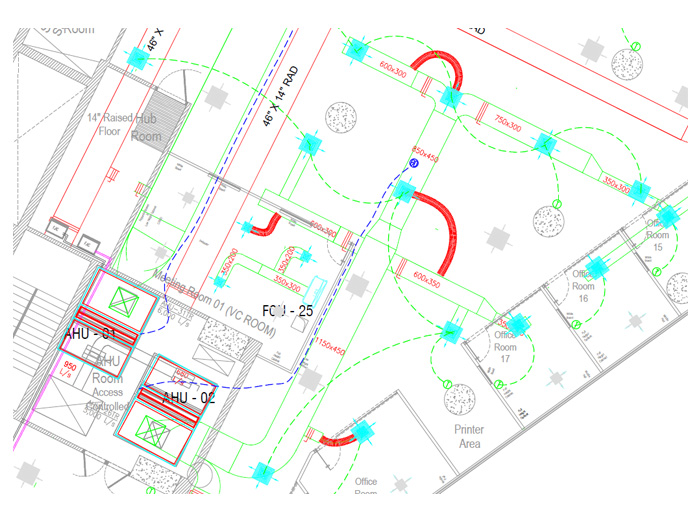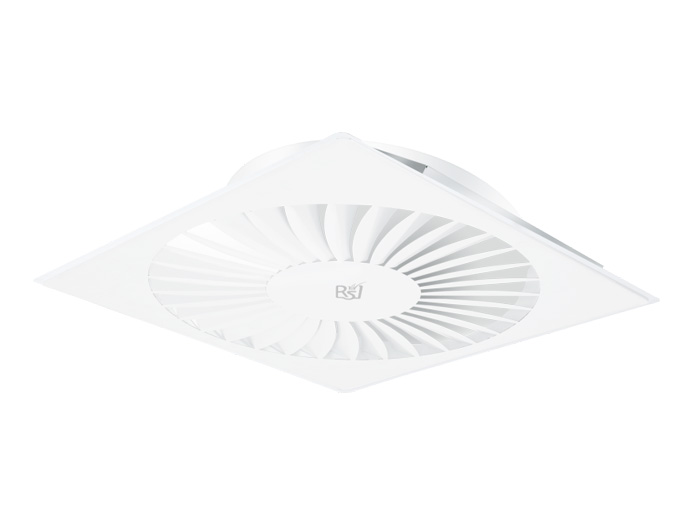Case Sharing of Variable Air Volume (VAV) Diffuser Applications
The Royal Service Variable Air Volume (VAV) diffuser is an independent temperature control unit that offers advantages such as low pressure drop, optimized airflow distribution, and diverse configurations. It provides an effective solution to uneven heating and cooling issues encountered in HVAC projects.
Case Study 1
Project:Office Room Renovation

Project Description:
The original office space was converted into conference rooms in this retrofit project, utilizing the existing AHU.
Execution strategy:
To meet the variable load demand of the conference room across operational periods, the project employs 4 RSV-SVAD-LL Linear Smart Variable Air Diffuser (Model SVAD-LL-4841). These devices dynamically modulate the supply airflow rate based on real-time space temperature feedback, achieving precise demand-controlled ventilation to maintain temperature stability.

RSV-SVAD-LL Linear Smart Variable Air Diffuse
Why SVAD?
1.An external temperature sensor is utilized, installed at return air grille, allowing the room thermostat to be installed at any position.
2.SVAD can consistently maintain optimal ceiling-proximity airflow pattern, ensuring no draft sensation at the seating area.
3.The SVAD linear diffuser is perfectly coordination with decorative dummy grilles.
Case Study 2
Project:Grade A office building half-floor office renovation

Project Description:
The 600+ square meter office space is served by the building's VAV system, featuring configurations where a single VAV-BOX supplies conditioned air to multiple rooms.
Execution strategy:
To achieve independent temperature control in each room, the project employs 4 RSV-SVAD-ST Square Smart Variable Air Diffuser, with three primary application configurations:
1.Single VAV-BOX Serving Large & Small Rooms The VAV-BOX thermostat remains in the large room, while the small room is equipped with an SVAD terminal for localized control.
2.Single-Duct VAV-BOX Serving more than 3 Rooms The existing single-duct VAV-BOX is retrofitted into pressure independent module (PIM), with SVAD terminals installed in each room to enable zone-specific temperature regulation.
3.New Branch Duct from Main Supply A branch duct is added to the main supply air system to serve multiple rooms. A PIM is installed on the branch duct, while SVAD terminals are used in individual rooms for precise control.
Why SVAD?
The SVAD system offers flexible retrofit capabilities, allowing the existing supply air ductwork to remain largely unchanged, with only the terminal diffusers requiring replacement.
Case Study 3
Project: Office Building Project

Project Description:
The VAV system employs motorized variable air volume (VAV) terminals, with hydraulic calculations meticulously performed during duct design to ensure that each VAV terminal's inlet static pressure remains within the 10-70 Pa range during maximum airflow operation.
Execution strategy:
The AHU fan operates efficiently by variable frequency drive (VFD) control based on the main duct static pressure setpoint, ensuring optimal system performance. Each VAV terminal in smaller rooms is equipped with an individual temperature control panel, while multiple VAV terminals in open office areas are grouped under a single centralized control panel.

RSV-SVAD-SW Square Swirl Variable Air Diffuser
Why SVAD?
1.Simplified Ductwork Installation
The duct system features streamlined construction and easy duct connections, reducing installation complexity and labor costs.
2.Plug-and-Play VAV Terminal Operation
With proper static pressure setpoints, the VAV terminals are operational upon installation, eliminating the need for complex individual unit commissioning.
3.Cost-Effective Solution for Small Rooms
Using a single VAV terminal in smaller rooms offers cost advantages over traditional VAV-BOX and standard diffuser configurations.
4.Precision Comfort Control in Open Office Areas
Multiple SVAD are deployed in open office spaces. Each SVAD terminal is equipped with an integrated temperature sensor, enabling granular zone temperature control to ensure thermal comfort across large areas while allowing individual adjustability.
5.Energy-Efficient Low-Pressure Duct System
The low-pressure duct system design achieves lower fan energy consumption compared to traditional VAV-BOX duct systems.
